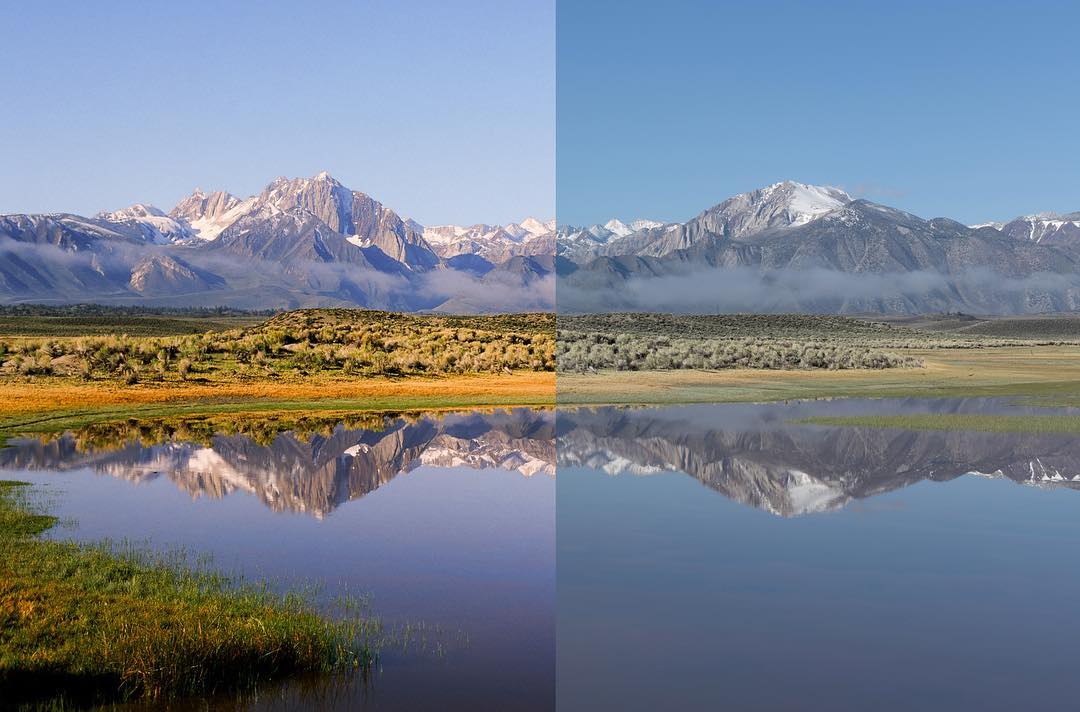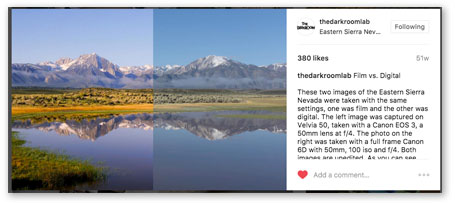What Type Of Camera Did Ansel Adams Use
With film usage and adoption on the ascension, we wanted to resurrect the debate of digital photos versus analog photos. As a picture processing lab, we obviously have a bias, so not going to say which is better, but to nowadays the differences and listing advantages.
While in Eastern Sierra Nevada, nosotros shot ii photos, one motion-picture show and the other digital. Both the digital photo and the film photograph were taken with the same settings. The left image was captured on Velvia 50, taken with a Canon EOS 3, a 50mm lens at f/4. The photo on the right was taken with a full-frame Canon 6D with 50mm, 100 iso, and f/4. Both images are unedited. As you can come across, Velvia fifty has a very fine grain and has rich, vibrant colors straight from the scan compared to the unedited JPEG from the Canon 6D. And yes, yous do have the choice to edit digital photos, but in that location's something special almost making a cute image in-camera on film and not having to spend any time editing!
Also, if you're looking for a petty less saturation, at that place are other smashing film choices, similar Provia 100, which isn't as saturated but still has smashing color and fine grain, or yous could get with a color negative moving-picture show which will give you lot more than subtle colors and has a wider range of exposure breadth.

Film Photography Advantages
- Lower initial cost than for a comparable digital camera
- With a higher dynamic range, film is better at capturing white's and blacks' details and tin't be replicated with digital cameras. Besides, film tin can capture subtle details lost in digital photography.
- Film is more forgiving of modest focusing issues and exposure bug.
- Moving-picture show captures photos at higher resolution than most digital cameras.
- Analog moving picture tin exist pushed or pulled multiple stops when needed, but the amount of contrast inside the image is affected. Some photographers use this to their advantage to create the platonic wait they desire, but this method still does non let extremely high ISO speeds without impacting epitome tones.
- Movie photographers with a limited number of exposures bachelor on a roll of film must think more than about their images before shooting them. Digital photographers tend to have pictures start and think later. Depending on your viewpoint, this is either an advantage or disadvantage.
- Unlike digital cameras, film cameras are future proof and don't become obsolete.
- No ability or batteries needed. Long trips and cold atmospheric condition tin can be limiting for digital cameras.
- The Darkroom photograph lab scans your film photos, at present allowing y'all to edit your images on a computer with photograph-editing software or share on social media.
Digital Photography Advantages
- The resolution in even point-and-shoot cameras, which is often 12 to xx megapixels, is high enough resolution for big prints.
- Digital cameras also have the advantage of being able to change film speeds between individual photographs.
- The cameras are generally lighter weight than motion-picture show cameras.
- Memory cards are tiny and can shop many images.
- Instant gratification and images can be viewed immediately. Some film photographers consider this a disadvantage.
- Y'all can edit your images directly on the camera.
- You lot can choose to print merely the images you like best.
- Many cameras offer built-in filters.
Picture Offers Color Consistency and Dynamic Range over Digital
Moving-picture show is the aureate standard of photography. Nada compares – non even digital. A expert example of this is when a motion-picture show company like Fujifilm tries to match film's beautiful color consistency. Such an 'advocacy' in technology is cipher more than a marketing gimmick.
Picture is the gilded standard of photography.
Have Provia and Velvia, for case; when Fujifilm tried to replicate these stunning film stocks into their mirrorless digital cameras, it was a lamentable twenty-four hour period indeed. Rather than making more film, they halted production and turned their attending to replicating the colour science in camera. Digital mirrorless owners rejoiced as they could now take photos enriched with 'Veliva' and 'Provia' simulations. Looking at these cameras' digital photos, the pic simulation event is simply a dial in contrast and saturation with some embedded metadata text. This type of marketing ploy has nothing on the traditional film stock we have been shooting for years. That'southward why when you pick up a roll of Velvia or Provia, you know that nothing is going to beat the original. The color consistency is famous in picture show and not as a digital reproduction.
Cheque out The Darkrooms movie index, reviews, and samples
Adding to this, the flick can capture a wider dynamic range (13 stops, to exist exact) than most digital cameras. Considering of this, you won't have to edit your highlights, lift your shadows, or increase saturation. The image is perfect in every mode. You tin't become the aforementioned results on a digital camera.
Resolution of Film is College Than Almost Digital Cameras
The championship above may seem far-fetched for those new to film, but let united states of america explain it to you lot. Moving picture is manufactured in various formats to suit a variety of cameras. This is much the same every bit the sensor sizes on digital cameras. All the same, unlike digital cameras, film tin can capture and shop at greater resolutions. More than specifically, when the film stock is larger, so is the photon count on the movie stock'due south surface.
For example, if we were to put a 120mm negative against a 35mm full-frame digital sensor, the film's resolution would trump the digital camera. This will exist more than evident at lower ISOs; notwithstanding, as y'all increment ISO, the signal-to-noise ratio drastically changes, and the digital sensor volition win in terms of resolution.
So if y'all are looking to shoot film at lower ISO's (Nether 800, let's say), then the resolution you can go will outperform a smaller sensor.
Amazing Photos with Cheap Cameras
Tiptop x Photography Podcasts for Film Photographers
Movie Processing And Editing Is Every bit Artistic As Taking The Shot
One of the key elements of film photography is the creative control offered throughout the processing and editing stages. Rather than beingness a majority-edit workflow every bit experienced in digital, at that place is a staged process involved with flick. Information technology is a process that is both enjoyable and challenging only even so one that you have full control over. One of the biggest advantages of film editing is the greater level of light management within the darkroom environment. Film offers a significant level of dynamic range with less blowout of highlights and loss of detail in shadow areas. Digital files can be incommunicable to recover from such issues.
While it is user-friendly that digital editing can be washed in-camera or on a digital device, it is often washed on the get. In that location is fulfillment and enjoyment in our busy globe to be gained in slowing down and working inside a darkroom a lab. Alternatively, many are now taking the time to work on high-resolution scans from film photography outings. With the right processing menstruation, film negatives will last a lifetime and tin can be used for scans or prints numerous times. Those in the digital earth live in constant fear of calculator crashes, hard drive failures, or even memory card corruption. There is nothing worse than a memory carte read fault while in the field or while trying to import images onto a computer.
Editing should exist far more merely pushing around sliders on a screen. Film processing and editing impacts all the senses and brings you closer to creative outcomes.
The Cost Of Film Photography Is More Manageable and Less Jarring Than Digital
Like information technology or not, the costs involved in photography's creative pursuit are a key consideration for many people. Both film and digital have unique cost considerations worth exploring – notwithstanding, motion-picture show photography has a gentler approach with a lower fiscal burden. With movie, your up-front costs are far less as film cameras' price is significantly lower than that of a modernistic DSLR or mirrorless kit. The price of some of the high-end models is staggering and would identify most under fiscal strain. Plus, y'all are shackled with the other drawbacks of being locked into the digital medium.
Pic photography spreads its costs out throughout your life every bit a lensman. Aside from the camera, the ongoing cost of motion-picture show is a low-cost chemical element – buying in bulk is e'er a smart choice as y'all are more likely to get out and shoot with a bag full of film. Plus, you lot salvage a niggling on each roll with a majority lot. From in that location, you are looking at lab and darkroom costs depending on how deep you want to dive. A pop solution is to manage lab costs by opting for digital scans of your picture. These scans are of the highest quality and retain all the quality and detail of your original shots. Plus, you now have total creative control of which direction you want to head and how much you want to spend.
You lot tin can at present take your digital scans and edit them further with your preferred editing software – or not at all. You can opt to print your scans at home or through a lab in whatsoever size and format you lot desire. And, if you lot are and then inclined, y'all can, of course, share your work on your site, blog, or via social media platforms. Either way, it is evident that yous will invest much less with moving picture throughout your photography life than y'all would through digital. Film cameras terminal lifetimes while digital-only concluding as long as their circuits agree-up.
Nosotros'd love to hear your thoughts on this topic in the comments below.
 This was originally posted on our Instagram (instagram.com/thedarkroomlab).
This was originally posted on our Instagram (instagram.com/thedarkroomlab).
Source: https://thedarkroom.com/film-vs-digital-comparison/
Posted by: kingfortsmaper.blogspot.com

0 Response to "What Type Of Camera Did Ansel Adams Use"
Post a Comment